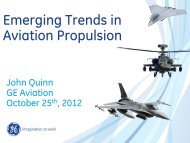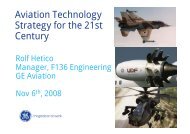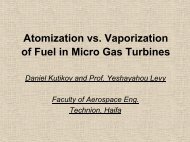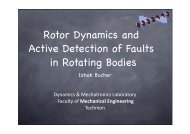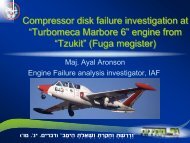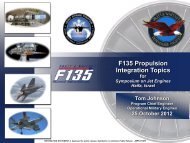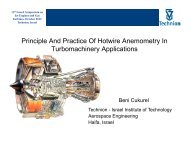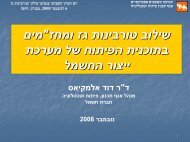Tip Noise Passive Control in Low Mach Number Axial Fan
Tip Noise Passive Control in Low Mach Number Axial Fan
Tip Noise Passive Control in Low Mach Number Axial Fan
- No tags were found...
Create successful ePaper yourself
Turn your PDF publications into a flip-book with our unique Google optimized e-Paper software.
<strong>Tip</strong> <strong>Noise</strong> <strong>Passive</strong> <strong>Control</strong> <strong>in</strong> <strong>Low</strong> <strong>Mach</strong><strong>Number</strong> <strong>Axial</strong> <strong>Fan</strong>Stefano BIANCHIXI Israeli Symposium of Jet Eng<strong>in</strong>es and Gas Turb<strong>in</strong>esHaifa, Israel, October 25 2012
Outl<strong>in</strong>es of civil aircraft issues
Introduction- Typically launch/recovery support personnel can beexposed to brutal acoustic loads of up to 150 dBA. Eachlaunch typically <strong>in</strong>volves a 30 sec average mil powerexposure (occasionally full AB).- The carrier deck personnel may experience up to 200launches/recoveries per 12 hr duty shift.Picture US NavyThe goal of eng<strong>in</strong>es noise reduction is considered of high importance.
- For high by pass ratio eng<strong>in</strong>es turb<strong>in</strong>e noise accountonly dur<strong>in</strong>g the Land<strong>in</strong>g operation, as the TO thrust isexerted ma<strong>in</strong>ly by the fan.- <strong>Low</strong> bpr eng<strong>in</strong>es are more senstive to turb<strong>in</strong>e noise,even for TO operation.NASA report: FS-1999-07-003-GRC- In low bpr eng<strong>in</strong>es turb<strong>in</strong>e noise is comparablewith the rear component of compressor noise:directed roughly to the eng<strong>in</strong>e side.Rolls-Royce, 2006
Techniques and concepts for tip treatment, a first review (ii)• Dur<strong>in</strong>g the last decade have appeared several passive noise control concepts basedon the blade tip modifications by means of anti-vortex appendagesanti-vortex devices as end-plates at the tiporig<strong>in</strong>ally <strong>in</strong>spired by the technique developed for the control of tip vortex and <strong>in</strong>duced dragreduction <strong>in</strong> aircraft w<strong>in</strong>gs, also used as anti-vortex devices for catamaran hullsKarman end-plateBoe<strong>in</strong>g, blended w<strong>in</strong>gletsF2005, rear w<strong>in</strong>glets
Conventional end-plate design• Base-l<strong>in</strong>e solution for the tip treatments, Cors<strong>in</strong>i et al. (2006, 2007), def<strong>in</strong>ed a bladeconfiguration with use of tip appendages to implement a control on leakage flowrotor AC90/6/TF tip blade section modified byan end-plate on pressure surface with squaretailtrail<strong>in</strong>g edgeTF end-platetip blade section is locally thickened of a factor3:1 wrt maximum thickness at the tip of datumbladeAccord<strong>in</strong>g to the theory beh<strong>in</strong>d the end-plate design, thisdimension was chosen as the reference radial dimension ofleakage vortex to be controlled approx. 0.2 0.1 blade span,(Inoue et al., 1986) (Cors<strong>in</strong>i et al., 2004).FMGroup @ DMA-Sapienza
Analysis on <strong>in</strong>ner work<strong>in</strong>gs of TF end-plates, tip leakage vortex burst<strong>in</strong>g• This f<strong>in</strong>d<strong>in</strong>g was <strong>in</strong> accordance with the existence of a vortex breakdownCriterion for VB detection based on vortex swirl analysisan <strong>in</strong>terpretive criterion to detect the appearance of vortex breakdown makes use of the Rossbynumber (or <strong>in</strong>verse swirl parameter) (Ito et al., 1985)Ro = V /(r W)Ro1.61.4design po<strong>in</strong>tfor a conf<strong>in</strong>ed vortex the scales are:r , radial distance from the vortex axis at whichthe swirl velocity was at its maximum<strong>in</strong> accord with characteristic viscouslength scale Leibovich (1984)V = waTLV, was taken to be the axial velocity1.210.8W, be the rotation rate <strong>in</strong> the w<strong>in</strong>g-tipvortices due to the solid body rotation-likestructure (estimated near the vortex centre).0.60.40.4 0.5 0.6 0.7 0.8fraction of chordbreakdown regionFMGroup @ DMA-Sapienza
End-plates for tip leakage vortex swirl control, design goals• The work is dedicated to sketch new concepts for the shap<strong>in</strong>g (design)of the anti-vortex tip end-plate• The rationale is to designate a variation of end-plate thickness, <strong>in</strong> order toimplement a manipulation of the chord-wise evolution of the leakage vortex swirlVisualization and Analytics Center for Enabl<strong>in</strong>g Technologies(VACET) DOE, USAAircraft Vortex Manipulation,Manipulation of the blade vortex <strong>in</strong>teractionof helicopters with nonplanar blade tips on the ma<strong>in</strong> rotorInstitute of Aeronautics and Astronautics, Aachen, Germany• The aim is to promote an enhancement or a detriment of near-axis swirl by <strong>in</strong>fluenc<strong>in</strong>gthe momentum transfer from the leakage flow and by <strong>in</strong>duc<strong>in</strong>g some wav<strong>in</strong>ess<strong>in</strong>to the leakage vortex trajectory, as attempted <strong>in</strong> delta-w<strong>in</strong>g platform designSrigrarom and Kurosaka (2000)FMGroup @ DMA-Sapienza
End-plate for Multiple Vortex Breakdown MVBconcept rationaleCors<strong>in</strong>i A, Rispoli F & Sheard AG, A Meridional<strong>Fan</strong>, Patent granted No. GB 2452104, July(2009)Rossby number def<strong>in</strong>ition for a conf<strong>in</strong>ed vortexTLV rotational frequency and length measuresgiven by Ra<strong>in</strong> (1954) and Lakshm<strong>in</strong>arayana (1970)Leakage flow modelled as a two-dimensional floworthogonal to the chord l<strong>in</strong>eAC90/6 fansdatumTF end-plateThe TLV Rossby number could beexpressed along the blade chord as afunction of:- gap geometry, (height & width)TFvte end-plate- k<strong>in</strong>etic energy of the leakage flowMVB end-plate- friction factor which is itself a function ofleakage flow Reynolds number, Regap- local blade load conditionsRo(xc)=f [tip gap, blade load, leakage flow, end-plate thickness]FMGroup @ DMA-Sapienza
CFD survey detailsdatumThe authors solved the Reynolds-Averaged Navier-Stokesequations by an orig<strong>in</strong>al parallel Multi-Grid F<strong>in</strong>ite Elementflow solver, us<strong>in</strong>g C++ technology and libMesh librariesTFThe physics <strong>in</strong>volved <strong>in</strong> the fluid dynamics of<strong>in</strong>compressible 3D turbulent flows <strong>in</strong> a rotat<strong>in</strong>g frame ofreference is modelled with a non-l<strong>in</strong>ear k-e model, here <strong>in</strong>its topology-free low-Reynolds variant.The F<strong>in</strong>ite Element flow solver uses second-order accurateapproximations <strong>in</strong> space for primary-turbulent variables.TFvteConcern<strong>in</strong>g the solution strategy, the authors solved theNavier-Stokes and turbulence equations fully coupled. Thel<strong>in</strong>ear solver uses a SOR preconditioned GMRES(5)technique.The mesh was built us<strong>in</strong>g a non-orthogonal body fittedcoord<strong>in</strong>ate system with block-structured topology. Themesh consists of about 0.6 million l<strong>in</strong>ear hexahedralelements.Standard boundary condition sett<strong>in</strong>gs were adopted, aspreviously used <strong>in</strong> studies on high-performance fansFMGroup @ DMA-Sapienza
datumMVB tip leakage flow surveyTLV detection helicity criterion (i)MVBTFTFvteIdentical TLV onset po<strong>in</strong>t wrt to datum and TFVortex core path deformation accord<strong>in</strong>g to theenhancement/detriment of swirlFMGroup @ DMA-Sapienza
TLV helicity & 3D streaml<strong>in</strong>esMVB tip leakage flow surveyTLV streaml<strong>in</strong>es (ii)datum TF TFvteswirl enhancementNo evidences of helicity <strong>in</strong>versionswirl detrimentNo evidences of separation cores, TLVgoes through the VB onset withoutactually burst<strong>in</strong>gMVBFMGroup @ DMA-Sapienza
MVB tip leakage flow survey, TKE & n t (iii)Turbulent k<strong>in</strong>etic energy iso-surfacesMVB0.80.80.20.20.80.2datum rotor AC90/6/TF AC90/6/TFvteNormalized turbulent viscosity nt iso-surfacesnt_2: 10 2 nmol;nt_1: 5× 10 nmoln t _1n t _1n t _1MVBn t _2n t _2n t _1n t _2datum rotor AC90/6/TF AC90/6/TFvteFMGroup @ DMA-Sapienza
Turbulent k<strong>in</strong>etic energy iso-surfacesMVBLw dB(A)frequency (Hz)Normalized turbulent viscosity nt iso-surfacesThe noise has a broadband characteristicMVBTones are due to the tip leakage flow <strong>in</strong> thepressure sideBoundary layer separation appears <strong>in</strong> the suctionside at the trail<strong>in</strong>g edgeFMGroup @ DMA-SapienzaFLAKT WOODS Ltd
operat<strong>in</strong>g po<strong>in</strong>t 8 m3/snarrow band (3 Hz) sound pressure level spectraMVB rotor performance assessmentaeroacoustics (ii)sound power spectra <strong>in</strong> one-third octave bandBPFmotor signatureFMGroup @ DMA-Sapienza
FMGroup @ DMA-SapienzaMVB rotor performance assessmentaeroacoustics (iii)
Experimental techniques, rig (i)<strong>Fan</strong> tested @ 8 – 6 m 3 /sAnechoic chamber BS848 p2Far-fieldmicrophone<strong>Noise</strong> measurements @ farfield:Span traversed microphone(when operat<strong>in</strong>g <strong>in</strong> the rig)• distance = 2 rotor D from the fan section• six azimuthal positions = 0° = 90° = 75° = 60° = 45° = 30°Pressure measurements @ nearfield:• distance d=15 mm from the trail<strong>in</strong>g edge2% of the chord• spanwise travers<strong>in</strong>g microphone <strong>in</strong> 14positions (10% span each)FMGroup @ DMA-Sapienza
Experimental techniques, data post-process<strong>in</strong>g (ii)Near-fieldFar-fieldHypotesis:- H(t,r) L<strong>in</strong>ear throug the anechoic space- H(t,r) depends only from geometriestipS(t,1)H(t,1)Cross-correlation, between near- and far-fieldAuto&cross spectra G SS G NN G SNS(t,r)H(t,r)S(t,0)H(t,0)∑N(t)Coherence:Co2GGSS2SN GNNhubS(t,r)H sound (t,r)H psdSound (t,r)H(t,r)D(t,r)N(t,r)To far-fieldFMGroup @ DMA-Sapienza
datumNorm Freq (ʄ = f/BPF) ʄ = 1 - 7MVB rotor performance assessmentNear-field aeroacoustic sourcedissection (ii)TFMVBSource characterization – Spanwise Coherence map @ 30°Norm Freq (ʄ = f/BPF) ʄ = 1 - 7TFvteAC90/6/TFMVBFMGroup @ DMA-Sapienza
Conclusions• The passive control technique explored <strong>in</strong> the study was based on blade tips that hadbeen modified by the addition of anti-vortex appendages as end-plates.• The end-plate configuration aimed to control the chord-wise evolution of the leakagevortex swirl level by prevent<strong>in</strong>g the occurrence of tip-leakage vortex burst<strong>in</strong>g by theenhancement of near-axis swirl.• The leakage-flow survey has shown that the variable-thickness configuration MVB wasable to exert control over near-axis leakage vortex swirl.As a result, although the critical Rossby number region is reached,the end-plate configuration provides effective control over leakage vortex burst<strong>in</strong>g.• The comparative aerodynamic and aeroacoustic assessment, demonstratedthe overall ga<strong>in</strong> for the <strong>in</strong>vestigated end-plates was found to be a consequenceof the implemented passive flow control concept act<strong>in</strong>g on the tip leakage flow
Thank you!(Cors<strong>in</strong>i A, Rispoli F & Sheard AG, A Meridional <strong>Fan</strong>, Patent granted No. GB 2452104, July2009)FMGroup @ DMA-Sapienza
ackup slideMVB rotor performance assessmentaerodynamics (i)FMGroup @ DMA-Sapienza
ackup slideMVB design concept, sensitivity analysessensitivity on tip gapsensitivity on lift @ blade tipFMGroup @ DMA-Sapienza



